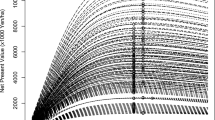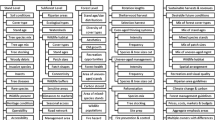Abstract
Policy makers need research based decision analysis models that include carbon sequestration and forest products in order to make policies that are both economically viable and effective. Forests and wood products have been identified as important mechanisms for carbon sequestration and storage. Policies often cover carbon sequestration but not product storage and substitution. Furthermore, many researchers have developed and published models on carbon management. However, a gap exists in operational level models that include product substitution. We developed a model to investigate optimal stand level management with competing objectives of maximizing soil expectation value, carbon storage in the forest, and carbon dioxide emission savings from product storage and substitution. Our purpose was to produce an accurate and usable analytical product for Southeastern U.S. foresters growing loblolly pine (Pinus taeda) in the presence of carbon policies. The decision variables were traditional stand level management variables: planting density, thinning timing and density, and rotation length. Over time these variables influence the proportion of wood going into pulp, chip-n-saw, and sawtimber where each of these classes has an expected use (carbon storage) life. Compromise programming was employed to solve the multiple-objective problem and to demonstrate the tradeoffs between the competing objectives. This type of model demonstrates a practical method for comparing tradeoffs associated with adjusting forest management for a carbon market. The difference in costs among objectives is important for decision makers considering climate change policies, as it represents the minimum value a rational landowner would accept to sequester a unit of carbon.


Similar content being viewed by others
References
Backeus, S., Wikstrom, P., & Lamas, T. (2005). A model for regional analysis of carbon sequestration and timber production. Forest Ecology and Management, 216, 28–40.
Bergman, R., & Bowe, S. (2010). Environmental impact of manufacturing softwood lumber in the Northeastern and North central United States. Wood and Fiber Science, 42, 67–78.
Briggs, D. (1994). Forest product measurements conversion factors. Washington: College of Forest Resources, University of Washington.
Buford, M. (1991). Performance of four yield models for predicting stand dynamics of a 30-year-old loblolly pine spacing study. Forest Ecology and Management, 46, 23–38.
Buford, M., & Hafley, W. (1985). Probability distributions as models for mortality. Forest Science, 31, 331–341.
Cao, T., Valsta, L., & Makela, A. (2010). A comparison of carbon assessment methods for optimizing timber production and carbon sequestration in Scots pine stands. Forest Ecology and Management, 260, 1726–1734.
Davis, L., Johnson, K., Bettinger, P., & Howard, T. (2001). Forest management (4th ed.). New York: McGraw Hill.
Del Lungo, A., Ball, J. & Carle, J. Global planted forests thematic study: results and analysis, FAO planted forests and trees working paper 38, Rome.
Dwivedi, P., Alavalapati, J., Susaeta, A., & Stainback, A. (2009). Impact of carbon value on the profitability of slash pine plantations in the Southern United States: an integrated life cycle and Faustmann analysis. Canadian Journal of Forest Research, 39, 990–1000.
Dwivedi, P., Bailis, R., Bush, T., & Mainescu, M. (2011). Quantifying GWI of wood pellet production in the Southern United states and its subsequent utilization for electricity production in the Netherlands/Florida. Bioenergy Research, 4, 180–192.
EC (2009). Directive 2009/28/EC of the European Parliament and of the Council. Official Journal of the European Union, 140, 16–47.
Eriksson, E., Gillespie, A., Gustavsson, L., Langvall, O., Olsson, M., Sathre, R., & Stendahl, J. (2007). Integrated carbon analysis of forest management practices and wood substitution. Canadian Journal of Forest Research, 37, 671–681.
FAO (2010). Global forest resources assessment 2010 main report. FAO forestry paper 163, Rome.
Franklin Associates, a division of ERG (2011). Life cycle inventory of foam polystyrene, paper-based, and PLA foodservice products. Accessed via web 4 August 2011. http://plasticfoodservicefacts.com/Life-Cycle-Inventory-Foodservice-Products
Fylstra, D., Lasdon, L., Watson, J., & Waren, A. (1998). Design and use of the microsoft excel solver. Interfaces, 28, 29–55.
Galik, C., Mobley, M., & Richter, D. (2009). A virtual “field test” of forest management carbon offset protocols: the influence of accounting. Mitigation and Adaptation Strategies for Global Change, 14, 677–690.
Gershon, M. (1982). The role of weights and scales in the application of multiobjective decision making. European Journal of Operational Research, 15, 244–250.
GGLS8 (2010). Green house gasses and energy balance calculation standard. Green Gold Label Program, web.
Hafley, W., & Buford, M. (1985). A bivariate model for growth and yield prediction. Forest Science, 31, 237–247.
Hafley, W., Smith, W., & Buford, M. (1982). A new yield prediction model for unthinned loblolly pine plantations. Technical report No. 1, Bioeconomic modeling project, Southern Forest Research Center, School of Forest Resources, North Carolina State University, Raleigh, NC.
Heath, L., Hansen, M., Smith, J., Smith, W., & Miles, P. (2008). Investigation into calculating tree biomass and carbon in the FIADB using a biomass expansion factor approach. Fort Collins: U.S. Department of Agriculture (RMRS-P-56CD).
Hennigar, C., MacLean, D., & Amos-Binks, L. (2008). A novel approach to optimize management strategies for carbon stored both in forests and wood products. Forest Ecology and Management, 256, 786–797.
Huang, C., & Kronrad, G. (2006). The effect of carbon revenues on the rotation and profitability of loblolly pine plantations in East Texas. Southern Journal of Applied Forestry, 30, 21–29.
Hyytiainen, K., Tahvonen, O., & Valsta, L. (2005). Optimum juvenile density, harvesting, and stand structure in even-aged Scots pine stands. Journal of Forest Economics, 51, 120–133.
IPCC (2006). 2006 IPCC guidelines for national greenhouse gas inventories. Prepared by the National greenhouse gas inventories programme, Eggleston H. S., Buendia L., Miwa K., Ngara T. and Tanabe K. (eds). IGES, Japan.
IPCC (2007). Nabuurs G., Masera O., Andrasko K., Benitez-Ponce P., Boer R., Dutschke M., Elsiddig E., Ford-Robertson J., Frumhoff P., Karjalainen T., Krankina O., Kurz W., Matsumoto M., Oyhantcabal W., Ravindranath N., Sanz Sanchez J., Zhang X. Forestry in climate change 2007: mitigation. Contribution of working group III to the fourth assessment report of the intergovernmental panel on climate change [B. Metz, O.R. Davidson, P.R. Bosch, R. Dave, L.A. Meyer (eds.)], Cambridge University Press, Cambridge, United Kingdom and New York, NY, USA.
IPCC (2011). Summary for policymakers. In O. Edenhofer, R. Pichs-Madruga, Y. Sokona, K. Seyboth, P. Matschoss, S. Kadner, T. Zwickel, P. Eickemeier, G. Hansen, S. Schlömer, & C. von Stechow (Eds.), IPCC special report on renewable energy sources and climate change mitigation. Cambridge: Cambridge University Press.
Jimenez, J., Rattan, L., Russo, R., & Leblanc, H. (2008). The soil organic carbon in particle-size separates under different regrowth forest stands of North Eastern Costa Rica. Ecological Engineering, 34, 300–310.
Kaipainen, T., Liski, J., Pussinen, A., & Karjalainen, T. (2004). Managing carbon sinks by changing rotation length in European forests. Environmental Science & Policy, 7, 205–219.
Krcmer, E., van Kooten, G., & Vertinsky, I. (2005). Managing forest and marginal agricultural land for multiple tradeoffs: compromising on economic, carbon and structural diversity objectives. Ecological Modelling, 185, 451–468.
Lee, H. (1996). Supporting rural telecommunications: a compromise solutions approach. Annals of Operations Research, 68, 33–45.
Lippke, B., Wilson, J., Meil, J., & Taylor, A. (2010). Characterizing the importance of carbon stored in wood products. Wood and Fiber Science, 42, 5–14.
Liski, J., Pussinen, A., Pingoud, K., Makipaa, R., & Karjalainen, T. (2001). Which rotation length is favorable to carbon sequestration? Canadian Journal of Forest Research, 31, 2004–2013.
Meng, F., Bourgque, C., Oldford, S., Swift, D., & Smith, H. (2003). Combining carbon sequestration objectives with timber management planning. Mitigation and Adaptation Strategies for Global Change, 8, 371–403.
Milota, M., West, C., & Hartley, I. (2005). Gate to gate life-cycle inventory of softwood lumber production. Wood and Fiber Science, 37, 47–57.
NC Extension Forestry. Wood energy. May 2011. Web.
NCASI (2004). Critical review of forest product decomposition in municipal solid waste landfills. Technical bulletin No. 0872. Triangle Park: National Council for Air and Stream Improvement, Inc.
Nepal, P., Grala, R., & Grebner, D. (2012). Financial feasibility of increasing carbon sequestration in harvested wood products in Mississippi. Forest Policy and Economics, 14, 99–106.
Peng, C., Jiang, H., Apps, M., & Zhang, Y. (2002). Effects of harvesting regimes on carbon and nitrogen dynamics of boreal forests in central Canada: a process model simulation. Ecological Modeling, 155, 177–189.
Pohjola, J., & Valsta, L. (2007). Carbon credits and management of Scots pine and Norway spruce stands in Finland. Forest Policy and Economics, 9, 789–798.
Prodanovic, P., & Simonovic, S. (2003). Fuzzy compromise programming for group decision making. IEEE Transactions on Systems, Man and Cybernetics. Part A. Systems and Humans, 33(3), 358–365.
Puettmann, M., & Wilson, J. (2005). Life-cycle analysis of wood products: cradle-to-gate LCI of residential wood building materials. Wood and Fiber Science, 37, 18–29.
Rawlings, J., Pantula, S., & Dickey, D. (1998). Applied regression analysis: a research tool (2nd ed.). New York: Springer.
Sanchez, F., Carter, E., & Klepac, J. (2003). Enhancing the soil organic matter pool through biomass incorporation. Biomass & Bioenergy, 24, 337–349.
Sarkhot, D., Comerford, N., Jokela, E., & Reeves, J. (2007). Effects of forest management intensity on carbon and nitrogen content in different soil size fractions of a North Florida Spodosol. Plant and Soil, 294, 291–303.
Skog, K. (2008). Sequestration of carbon in harvested wood products for the United States. Forest Products Journal, 58, 56–72.
Smith, B., Miles, P., Vissage, J., & Pugh, S. (2003). Forest resources of the United States. Gen. tech. rep. NC-241, St. Paul, U.S. Department of Agriculture, Forest Service, North Central Research Station, 137 p.
Smith, B., Miles, P., Perry, C., & Pugh, S. (2009). Forest resources of the U.S. Gen. tech. rep. WO-78, Washington, U.S. Department of Agriculture, 2007, Forest Service, Washington Office, 336 p. Available at. http://www.fs.fed.us/nrs/pubs/gtr/gtr_wo78.pdf.
Smith, J., Heath, L., Skog, K., & Birdsey, R. (2006). Methods for calculating forest ecosystem and harvested carbon with standard estimates for forest types in the United States. General technical report NE-343, Newtown Square, U.S. Department of Agriculture, Forest Service, North Eastern Research Station, 216 p.
Sohngen, B., & Brown, S. (2008). Extending timber rotations: carbon and cost implications. Climate Policy, 8, 435–451.
Talbert, J., & Jett, J. (1981). Regional specific gravity values for plantation grown loblolly pine in the Southeastern United States. Forest Science, 27, 801–807.
UNFCCC Secretariat (2011). News. Accessed via web 4 August 2011. http://unfccc.int/2860.php.
Upton, B., Miner, R., Spinney, M., & Heath, L. (2008). The greenhouse gas and energy impacts of using wood instead of alternatives in residential construction in the United States. Biomass & Bioenergy, 32, 1–10.
van Kooten, G., Binkley, C., & Delcourt, G. (1995). Effect of carbon taxes and subsidies on optimal forest rotation age and supply of carbon services. American Journal of Agricultural Economics, 77, 365–374.
White, M., Gower, S., & Ahl, D. (2005). Life cycle inventories of roundwood production in Northern Wisconsin: inputs into an industrial forest carbon budget. Forest Ecology and Management, 219, 13–28.
Winston, W. (2004). Operations research: applications and algorithms (4th ed.). Belmont: Brooks/Cole.
Woodbury, P., Smith, J., & Heath, L. (2007). Carbon sequestration in the U.S. forest sector from 1990–2010. Forest Ecology and Management, 241, 14–27.
Acknowledgements
A portion of this research has been funded by a grant from the U.S. EPA’s P3 Program. Laurie Gharis was supported by a National Needs Fellowship co-sponsored by North Carolina State University’s Department of Forestry and Environmental Resources and the USDA-CSREES. The authors would also like to thank Richard Bergman, Puneet Dwivedi, Peter Lohmander, and Maureen Puettmann for their help.
Author information
Authors and Affiliations
Corresponding author
Rights and permissions
About this article
Cite this article
Gharis, L., Roise, J. & McCarter, J. A compromise programming model for developing the cost of including carbon pools and flux into forest management. Ann Oper Res 232, 115–133 (2015). https://doi.org/10.1007/s10479-013-1519-9
Published:
Issue Date:
DOI: https://doi.org/10.1007/s10479-013-1519-9




